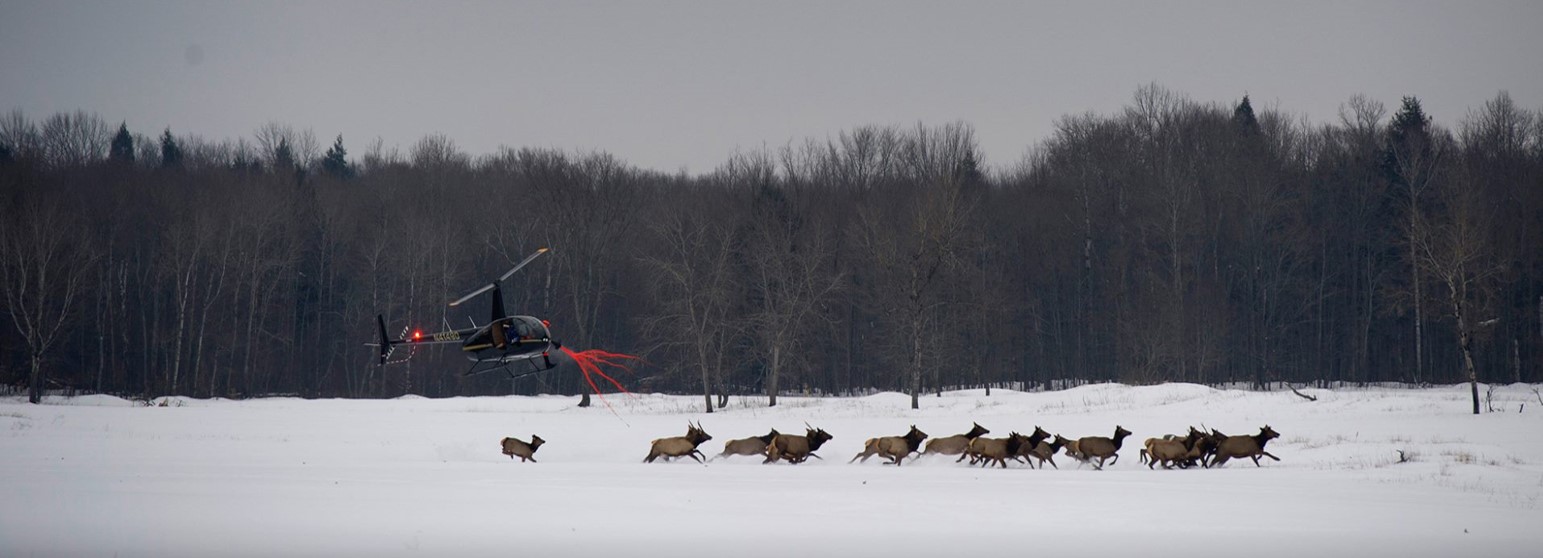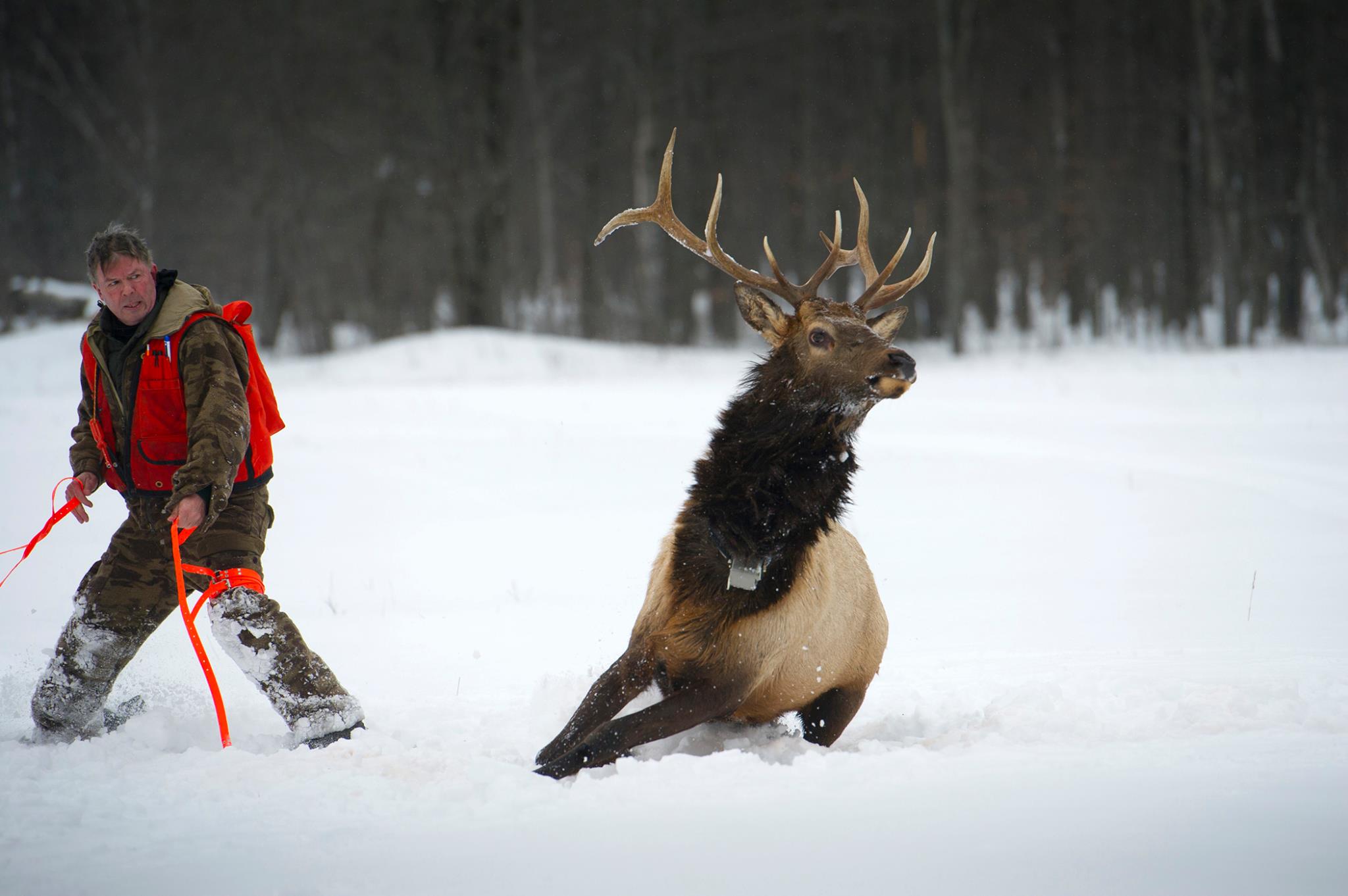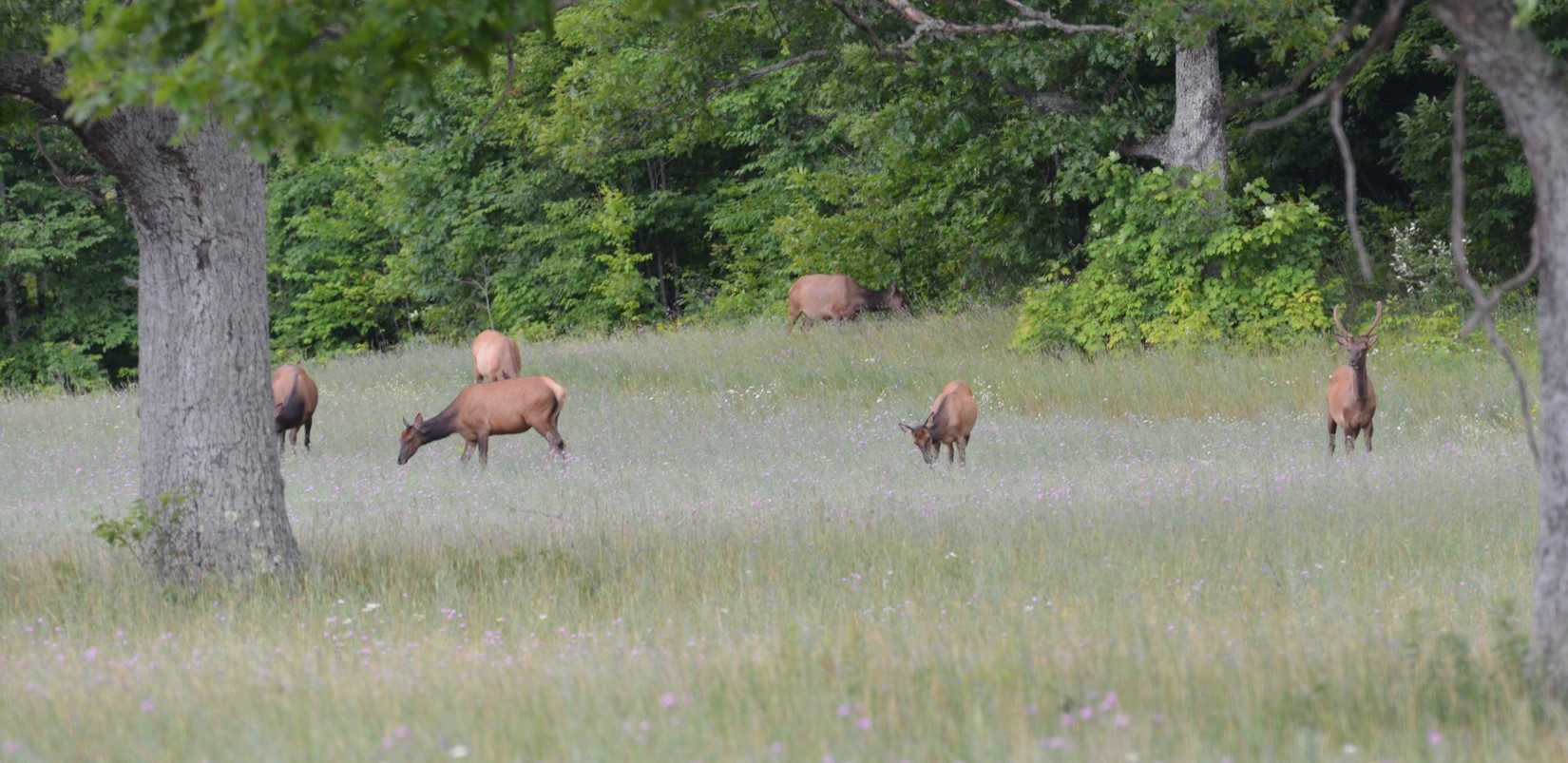BACKGROUND
Michigan’s elk management plan commits to managing for a sustainable elk population in balance with the habitat and supporting quality hunting and viewing opportunities. Over the past 20 years, elk use of areas outside the historic elk range has increased, leading to reduced public viewing opportunities, challenges to continued use of hunting to manage elk, and increasing human-elk conflict. Greater elk use of these outlying areas may be a result of seeking refuge from disturbance from recreational use or better habitat. Our research will inform population and habitat management decisions, hunting recommendations, management of private landowner-elk interactions and conflicts, and planning for public viewing opportunities.
STUDY AREA
Our study area of approximately 1,220 km² is the current Michigan elk range (Figure 1), and includes regions (i.e., state forest management units, Pigeon River Country, Atlanta, Gaylord) of the Mackinaw State Forest (664.9 km²) and private lands (555.1 km²) located within Cheboygan, Montmorency, Otsego, and Presque Isle counties in the northern portion of the lower peninsula of Michigan. The Pigeon River Country State Forest (458.4 km², PRC) and portions of the Atlanta State Forest (168 km², ASF) are considered the core of the Michigan elk range.

OBJECTIVES
- Quantify elk habitat suitability and potential on public and private lands within the Michigan elk range.
- Quantify the number and relative intensity, frequency, and geographic scope of recreational users (i.e., equestrian users, hikers, mountain bikers, ORV users) in the PRC (with restricted recreational activities) and ASF (with normal recreation restrictions) regions of the elk range in Michigan.
- Quantify elk resource selection and temporal movement patterns in response to the number and relative intensity and frequency and geographic scope of recreational users (i.e., equestrian users, hikers, mountain bikers, ORV users) in the PRC (restricted recreational activities) and ASF (normal recreation restrictions) regions of the elk range in Michigan.
- Quantify the fine scale responses (i.e., behavioral, spatial, temporal) of GPS-collared elk to experimentally applied recreational disturbances (i.e., equestrian use, mountain biking).
METHODS AND RESULTS
Elk Capture:
During February 15-16, 2016, personnel from Wildlife Helicopter Services (Austin, Texas, USA), Michigan Department of Natural Resources, and Michigan State University captured 18 adult elk in the PRC (7m, 11f) and 22 in the ASF (13m, 9f). Capture was performed by net-gunning techniques. Upon capture, all elk were ear tagged and fitted with a collar (GPS Plus Iridium) that included a Global Positioning System (GPS) receiver, and a VHF beacon transmitter (Vectronic Aerospace GmbH, Berlin, Germany).


On April 9, 2017, we used chemical immobilization to collar 1 bull in the Atlanta State Forest. Capture and collaring was led by Dr. Dean Beyer.
On Feb 22, 2018, personnel from Wildlife Helicopter Services (Austin, Texas, USA), Michigan Department of Natural Resources, and Michigan State University captured 7 adult elk (5m, 2f) in the PRC and 5 female adult elk in the ASF. Collaring was performed using the same methods as described above for 2016.
Modeling Elk Habitat Suitability and Potential:
Assessment of habitat suitability provides natural resource managers with insights on the quality and spatial distribution of habitat for wildlife species. However, habitat suitability models only provide information on current habitat parameters, and do not consider changes in habitat due to forest succession and disturbances. Habitat potential models have been developed by identifying habitat types and their successional trajectories to provide insights on how landscapes change with time. To demonstrate how integration of habitat suitability and habitat potential models can provide spatiotemporal insights on wildlife habitat, we developed habitat suitability index models and habitat potential models for elk on public and private lands within the Michigan elk range.
For our public lands models, we used state forest compartment inventory data to identify cover types important to elk, and assigned suitability values (0=low, 1=high) to each cover type for elk life requisites (i.e., spring food, winter food, winter thermal cover). Additionally, we modified suitability values based on stand conditions acquired from state forest inventory records (e.g., stand size, percent canopy closure, age of aspen). For our private lands models, we used satellite imagery to classify cover types and assigned suitability values to cover types for each elk life requisite, and modified values based on percent canopy closure for winter thermal cover. Elk habitat potential was modeled by delineating habitat types by overlaying digital spatial data layers (soils, land-type associations, vegetation) and identifying successional trajectories using habitat classification guides and literature. We assigned suitability values to each habitat type for life requisites at early to late successional stages. The highest suitability value of each habitat type’s successional stage determined the habitat potential for each habitat type.

On public lands, we found many areas of medium and high suitability for all elk life requisites. For spring food, we found many areas of medium suitability and few areas of high suitability. For winter food, we found many areas of medium and high suitability. For winter thermal cover, we found relatively fewer areas of medium and high suitability than winter food.
On private lands, we found many areas of medium and high suitability for all elk life requisites. For spring food, we found many areas of medium suitability and few areas of high suitability. For winter food, we found many areas of medium and high suitability. For winter thermal cover, we found relatively fewer areas of medium and high suitability than winter food. Figure 3: Elk habitat suitability for private lands and public lands in the Michigan elk range (2018).
We found medium to high habitat potential during at least one successional stage for nearly all of the elk range. For spring food, the majority of the elk range has medium-high habitat potential, with fewer areas having low or high potential. For winter food, the majority of the elk range has high habitat potential, with fewer areas having low or medium-high habitat potential. For winter thermal cover, we found a relatively even distribution of areas with low to high habitat potential.Figure 4: Elk habitat potential for the Michigan elk range.
We submitted a manuscript titled "Applications of Integrating Wildlife Habitat Suitability and Habitat Potential Models" to the Wildlife Society Bulletin on October 20, 2019. Our manuscript was accepted on June 9, 2020 and is currently in press.
Quantifying Human Recreation Use:
To evaluate recreational activity in 2 state forest areas with differing recreational use regulations, we examined summer and fall recreation patterns in the PRC and ASF. We quantified the intensities and group sizes of primary recreation types (i.e., equestrian use, hiking/foot-traffic, mountain biking, ORV use) at different time periods (i.e., year, month, day of week, time of day). Recreational use was monitored using trail cameras during May-October, 2016-2018. In the PRC, we selected sites for camera placement to maximize capturing recreational user activities on trails by focusing on intersections of trails, intersections of trails and forest roads, and trailheads. In the ASF, due to the limited number of designated trails, we used field observations of recreational activities to determine camera placements on forest roads and edges where we would observe the greatest intensity of recreational use. We recorded camera ID, date, time, recreation type, and group size for each image. Recreation events were defined as any number of individuals of the same recreation type passing by a camera within a 5-minute period. We calculated recreational intensity based on the number of events per camera hour for each time period. We used a statistical model (i.e., generalized linear mixed model) to determine which variables had the most effect on detection of a recreation event. To evaluate differences in group size among time periods for each recreation type, we used statistical tests (i.e., Kruskal-Wallis with group size as the response variable and time periods as independent variables, followed by post-hoc pairwise comparison tests to interpret model results among time periods and recreation types).
Evaluating Elk Resource Selection, Movements, and Behavior:
in progress
TIMELINE
The project was initiated in February 2016, with field research activities occurring through 2018. Project completion will occur in Fall 2020.
PUBLICATIONS
- Williamson, C. R., H. Campa, III, A. B. Locher, S. R. Winterstein, and D. E. Beyer, Jr. 2020. Applications of Integrating Wildlife Habitat Suitability and Habitat Potential Models. Wildlife Society Bulletin. In Press.
CONFERENCE PRESENTATIONS
- Williamson, C.R., H. Campa, III, A. B. Locher, S. R. Winterstein, and D. E. Beyer, Jr. 2019. Elk habitat suitability and potential of public and private lands in Michigan. Oral Presentation. Michigan Fish and Wildlife Conference. Gaylord, MI.
- Williamson, C.R., H. Campa, III, A. B. Locher, S. R. Winterstein, and D. E. Beyer, Jr. 2019. Elk habitat suitability and potential of public and private lands in Michigan. Oral Presentation. Midwest Fish and Wildlife Conference. Cleveland, OH.
- Williamson, C.R., H. Campa, III, A. B. Locher, S. R. Winterstein, and D. E. Beyer, Jr. 2018. Current elk habitat suitability of public and private lands in Michigan. Oral Presentation. Eastern Elk Management Workshop. Lewiston, MI.
- Williamson, C.R., H. Campa, III, A. B. Locher, S. R. Winterstein, S. Riley, and D. E. Beyer, Jr. 2017. Elk responses to recreational use and habitat potential in Michigan. Oral Presentation. Fisheries and Wildlife GSO Student Symposium. Michigan State University, East Lansing, MI.
CONTACTS
- Dr. Henry (Rique) Campa, III, Professor, Department of Fisheries and Wildlife, Michigan State
University, 517-353-2042, Email: campa@msu.edu - Dr. Dean Beyer, Wildlife Research Specialist, Wildlife Division, Michigan Department of
Natural Resources, 906-227-1627, Email: beyerd@michigan.gov - Chad Williamson, PhD Candidate, Department of Fisheries and Wildlife, Michigan State
University, 810-869-9960, Email: will3004@msu.edu




 Print
Print Email
Email